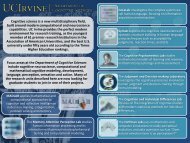Conscious Realism and the Mind-Body Problem - UCI Cognitive ...
Conscious Realism and the Mind-Body Problem - UCI Cognitive ...
Conscious Realism and the Mind-Body Problem - UCI Cognitive ...
Create successful ePaper yourself
Turn your PDF publications into a flip-book with our unique Google optimized e-Paper software.
<strong>Conscious</strong> <strong>Realism</strong> <strong>and</strong> <strong>the</strong> <strong>Mind</strong>-<strong>Body</strong> <strong>Problem</strong> 95is or how recently it was modified. The icon sits at some spot on <strong>the</strong>display, perhaps in <strong>the</strong> upper right. But this does not mean that <strong>the</strong> fileitself is in <strong>the</strong> upper right of <strong>the</strong> computer. The location of an icon on<strong>the</strong> display is, in part, simply a convenient way to keep track of it. Thereis, in short, no resemblance between properties of <strong>the</strong> icon <strong>and</strong> propertiesof <strong>the</strong> file. This is no problem, no failure of veridicality. It is <strong>the</strong> intendedconsequence of friendly formatting.The interface also helps <strong>the</strong> user by means of concealed causality. Notonly is <strong>the</strong> structural complexity of <strong>the</strong> computer hidden behind icons,but also its causal complexity. When you drag <strong>the</strong> file icon to <strong>the</strong> recyclebin <strong>and</strong> release, does moving <strong>the</strong> file icon to <strong>the</strong> recycle bin icon causedeletion of <strong>the</strong> file ? No. Icons have no causal powers within <strong>the</strong> computer.They are patterns of pixels on <strong>the</strong> display, <strong>and</strong> send no signals back to<strong>the</strong> computer. The complex causal chain within <strong>the</strong> computer that deletes<strong>the</strong> file is hidden, behind <strong>the</strong> interface, from <strong>the</strong> user. And nothing in <strong>the</strong>movement of <strong>the</strong> file icon to <strong>the</strong> recycle-bin icon resembles anything in thiscausal chain. Is this a failure or misrepresentation of <strong>the</strong> interface ? To<strong>the</strong> contrary, it is <strong>the</strong> reason for <strong>the</strong> interface. Hiding causal complexityhelps <strong>the</strong> user to quickly <strong>and</strong> easily delete a file, create a new one, modifyan illustration, or format a disk, without distraction by a myriad of causaldetails.Although <strong>the</strong> icons of <strong>the</strong> interface have no causal powers <strong>the</strong>y arenone<strong>the</strong>less useful by providing clued conduct. The icons effectively informactions of <strong>the</strong> user, allowing <strong>the</strong> user to trigger <strong>the</strong> appropriate, buthidden, causal chains. 1 In <strong>the</strong> case of deleting a file, <strong>the</strong> icon of <strong>the</strong> fileinforms <strong>the</strong> user how to click <strong>the</strong> mouse, <strong>and</strong> <strong>the</strong> icon of <strong>the</strong> recycle bininforms <strong>the</strong> user how to release <strong>the</strong> mouse, so that appropriate causalchains are triggered inside <strong>the</strong> computer, resulting in deletion of <strong>the</strong> file.Icons inform an effective perception-action loop, without <strong>the</strong>mselves havingcausal powers in <strong>the</strong> computer.To <strong>the</strong> extent that a user interface succeeds in providing friendly formatting,concealed causality, <strong>and</strong> clued conduct, it will also offer ostensibleobjectivity. Usually <strong>the</strong> user can act as if <strong>the</strong> interface is <strong>the</strong> total reality of<strong>the</strong> computer. Indeed some users are fooled; we hear humorous stories ofa child or gr<strong>and</strong>parent who wondered why an unwieldy box was attachedto <strong>the</strong> screen. Only for more sophisticated purposes, such as debugginga program or repairing hardware, does dissolution of this illusion becomeessential.1 Here, <strong>and</strong> throughout <strong>the</strong> paper, <strong>the</strong> verb trigger means “to initiate a sequence ofactions, typically causal <strong>and</strong> complex.” To say, for instance, that stress triggers cardiovasculardisease means that stress initiates a complex causal sequence of biochemicalinteractions that eventuate in <strong>the</strong> disease.







